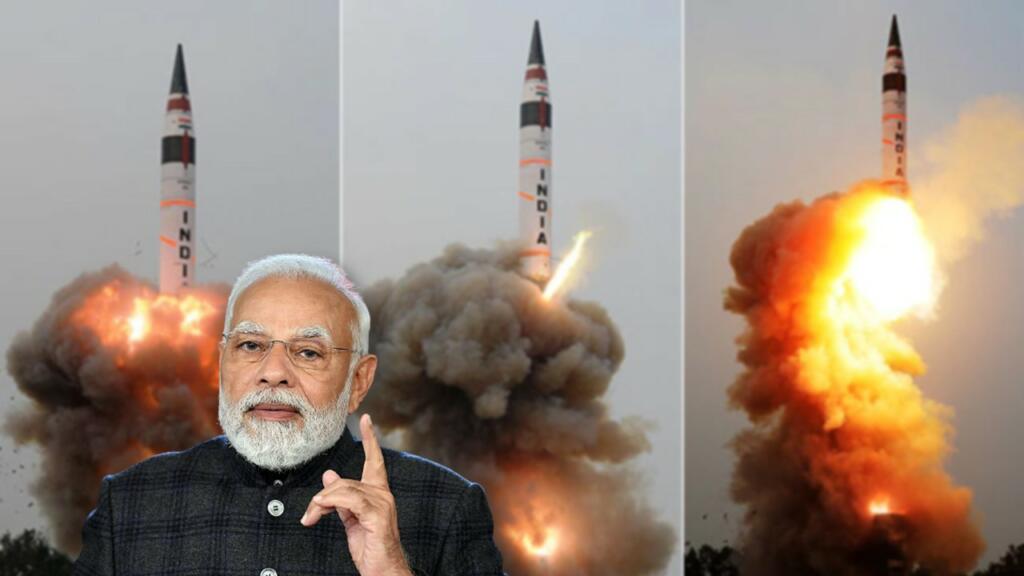Pralay and Nirbhay missiles: Over the years, India has developed incredible capabilities in the nuclear triad. What is a nuclear triad? It refers to the capability of launching nuclear weapons from land, air, and sea. It is crucial in ensuring credible nuclear deterrence so that potential adversaries refrain from launching a nuclear attack in the fear of devastating nuclear retaliation.
In 2016, India achieved this milestone when it commissioned INS Arihant. It is a nuclear-powered submarine that is capable of launching nuclear ballistic missiles. This completed India’s nuclear triad, which has since been fully operational. The Agni series, air delivery platforms, and submarine-launched nuclear missiles are part of India’s nuclear programme.
But despite India having nuclear triad and minimum credible deterrence, Indian Nuclear doctrine necessitates India to develop similar potent capabilities through conventional missiles.
Also read: Amit Shah’s sharp response to China’s attempted naming of 11 Indian places
India to build conventional missile deterrence
As per the stated nuclear doctrine, India follows a no-first-use policy for nuclear weapons. But, in case of a nuclear strike, India will ensure that the adversary suffers maximum destruction, even to the point of no return. But the no-first-use policy has prompted India to develop a deterrence through conventional missiles as well. This becomes necessary, especially keeping an eye on the Chinese threat along our borders in the North-East.
As per reports, India has decided to secure the north-east with Pralay and Nirbhay missiles. This is being done keeping in mind the vulnerabilities in the Siliguri corridor and to protect Bhutanese territory from Chinese aggression.
These reports add to the fact that the Union government led by PM Modi is heading towards building a robust conventional warhead missile deterrence to counter CCP’s expansionist plans. For territorial land grabbing, China adopts salami-slicing tactics, short-duration skirmishes, or conventional war.
In cases of short-duration warfare, nuclear brinkman ship and the use of nuclear missiles will be out of the picture, as they will be overkill for skirmishes. This is where missiles with conventional warheads will deliver the intended cold message to our hostile neighbour.
Also read: The Who’s who of Maritime collaborates in the Indo-Pacific against China
Defence experts and people aware of the matter state that the national security planners have decided to secure the north-eastern states against Chinese territorial aggression. For this, the Indian armed forces will use conventionally armed short-range ballistic missiles like Pralay.
Now, the maximum striking range of Pralay is said to be around 500 kilometres. Additionally, the forces will also use the conventionally armed subsonic cruise missile Nirbhay. Its maximum range is reported to be around 1500 kilometres.
Further, India has other conventional delivery platforms to carry out an attack against the hostile nation. Earlier, India’s premier Defence Research and Development organisation, DRDO, conducted development trials of both the Pralay and Nirbhay missiles.
Now, there are promising reports that user trials are expected to be concluded soon. In fact, the Defence Ministry has already placed orders for the Pralay missile. After this development, India’s nuclear arsenal will provide a solid backup to its conventional deterrent.
Also read: DRDO Sets its Sights on Pakistan and China with advanced artillery gun system
China’s nuclear posture
India shares a large land border with China. Along the 3488-km Line of Actual Control (LAC), China’s PLA has deployed rocket regiments, and it has time and again thrown border agreements for a toss. In order to threaten Indian airspace in the worst-case scenario, the Chinese PLA has already stationed HQ-16 surface-to-air missiles that have a 70-kilometre range in the Yatong area across the Siliguri corridor.
This has necessitated India to step up its guard against Chinese aggression on the Siliguri Corridor and in Arunachal Pradesh. India has been deploying potent counter-weapons.
In light of this, Indian national security planners have deployed missile defence systems, reinforced fighter shelters for the IAF, and ammunition storage facilities to counter Chinese deployment in the Siliguri corridor and the north-eastern regions.
Further, in order to deter any US military assault against the Middle Kingdom, China is openly deploying its nuclear deterrent with new missile silos in the provinces of Hami in Hotan, Yumen in Gansu, and Hanggin Banner in Inner Mongolia.
The Hami nuclear missiles in East Turkestan’s Taklamakan desert are said to have more than 230 missile silos that are visible to the public. This clearly gives a message to the rest of the world about the strength of China’s nuclear missile capacity.
Also read: China conundrum: EU doesn’t practice what it preaches to India
Conventionally armed ballistic and cruise missiles are placed in front of its nuclear weapons to engage the enemy. The Chinese hostility towards Taiwan is serious, and it also serves as a call for submission from ASEAN nations, including client states like Cambodia and Laos, even as the PLA builds new locations. As a result of the growing BRI debt, just one ASEAN nation, the Philippines, has chosen to oppose the CPC at this time.
China is giving its vassal state, Pakistan, 039-class diesel attack submarines and armed drones. This is done while keeping an eye on India’s western front, and this further complicates matters for India. For this reason, the Indian Navy is expected to grant Mazagon Dockyards Limited (MDL) the contract for three additional Scorpene-class submarines and to bolster conventionally armed rocket and missile capabilities on the western frontier.
Just like India, China claims to follow a ‘no-first-use policy’ in its nuclear doctrine. But China being China, no Chinese documents, remarks, or promises can be taken at face value. Thus, it is a major landmark for India to achieve deterrence with both conventional as well as nuclear weapons.
Support TFI:
Support us to strengthen the ‘Right’ ideology of cultural nationalism by purchasing the best quality garments from TFI-STORE.COM
